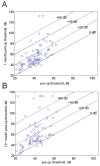The Hybrid cochlear implant: a review
- PMID: 19955729
- PMCID: PMC4274269
- DOI: 10.1159/000262604
The Hybrid cochlear implant: a review
Abstract
The Hybrid S or 'short-electrode' cochlear implant was developed to treat patients with a severe to profound hearing loss limited to the high frequencies. The short electrode is implanted into just the base or high-frequency region of the cochlea, with the goal of preserving residual low-frequency hearing. As a result, electric stimulation can be combined with acoustic stimulation in the same ear (and the opposite ear); this is one instance of 'acoustic plus electric' (A + E) stimulation. In this paper, we will review the latest findings from the first two stages of the clinical trial for the Hybrid concept in the United States. Generally, we will review surgical techniques, clinical trial criteria, residual hearing preservation, improvements in speech perception in quiet, and predictive factors for patient benefit. We will also discuss the significant benefit of A + E stimulation for speech perception in noise and musical measures of melody and instrument recognition, as well as valuable insights into central auditory nervous system plasticity gained from the use of a very short electrode array.
Copyright 2010 S. Karger AG, Basel.
Figures



References
-
- Gantz BJ, Turner CW. Combining acoustic and electric hearing. Laryngoscope. 2003;113:1726–1730. - PubMed
-
- Gantz BJ, Turner CW. Combining acoustic and electric speech processing: Iowa/Nucleus Hybrid Implant. Acta Otolaryngologica. 2004;24:344–347. - PubMed
-
- Hogan C, Turner CW. High-frequency amplification: Benefits for hearing-impaired listeners. J Acoust Soc Am. 1998;104:432–441. - PubMed
-
- Ching T, Dillon H, Bryne D. Speech recognition of hearing-impaired listeners: Predictions from audibility and the limited role of high-frequency amplification. J Acoust Soc Am. 1998;103:1128–1140. - PubMed
-
- Turner CW. Hearing Loss and the Limits of Amplification. Audiol Neurotol. 2006;11(Suppl 1):2–5. - PubMed
Publication types
MeSH terms
Grants and funding
LinkOut - more resources
Full Text Sources
Other Literature Sources
Medical
Research Materials

